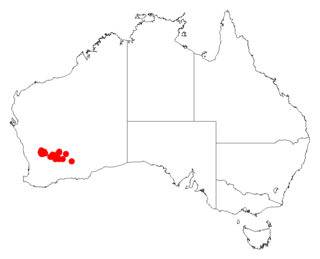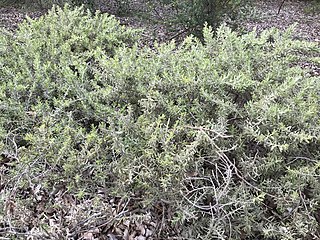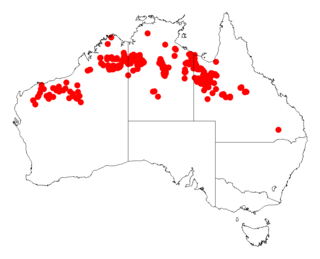
Acacia cylindrica is a shrub belonging to the genus Acacia and the subgenus Juliflorae that is endemic to western Australia.

Acacia latior is a shrub belonging to the genus Acacia and the subgenus Juliflorae that is endemic to western Australia.

Acacia xanthocarpa is a shrub belonging to the genus Acacia and the subgenus Juliflorae that is endemic to aris parts of western Australia.

Acacia yorkrakinensis is a shrub belonging to the genus Acacia and the subgenus Juliflorae that is native to Western Australia.

Acacia adenogonia is a shrub of the genus Acacia and the subgenus Plurinerves that is endemic to north western Australia.

Acacia aulacophylla is a shrub of the genus Acacia and the subgenus Plurinerves that is endemic to western Australia.

Acacia hadrophylla is a shrub of the genus Acacia and the subgenus Plurinerves that is endemic to south western Australia.

Acacia kenneallyi is a shrub or tree of the genus Acacia and the subgenus Plurinerves that is endemic to north western Australia.

Acacia lanuginophylla, or woolly wattle, is a shrub of the genus Acacia and the subgenus Plurinerves that is endemic to south western Australia. It is currently listed as a vulnerable species according to the Environment Protection Biodiversity Conservation Act 1999.

Acacia nivea is a shrub of the genus Acacia and the subgenus Plurinerves that is endemic to south western Australia.

Acacia obesa is a shrub of the genus Acacia and the subgenus Plurinerves that is native to a small area of south western Australia.

Acacia octonervia is a shrub of the genus Acacia and the subgenus Plurinerves that is endemic to a small area along the south western coast of Australia.

Acacia ophiolithica is a shrub of the genus Acacia and the subgenus Plurinerves where it is endemic to a small area along the south west coast of Australia.
Acacia papulosa is a shrub of the genus Acacia and the subgenus Plurinerves that is endemic to a small area along the south coast of south western Australia.
Acacia pelophila is a shrub of the genus Acacia and the subgenus Plurinerves that is endemic to a small area along the west coast of western Australia.

Acacia recurvata, commonly known as the recurved wattle, is a shrub of the genus Acacia and the subgenus Plurinerves that is endemic to a small area of western Australia.

Acacia retivenea, commonly known as the net-veined wattle, is a shrub of the genus Acacia and the subgenus Plurinerves that is endemic across northern Australia.

Acacia trulliformis is a shrub of the genus Acacia and the subgenus Plurinerves that is endemic to an area of south western Australia.

Acacia undosa is a shrub of the genus Acacia and the subgenus Plurinerves that is endemic to an area of south western Australia.

Acacia vittata, commonly known as Lake Logue wattle, is a shrub of the genus Acacia and the subgenus Plurinerves that is endemic to a small area in western Australia.




















